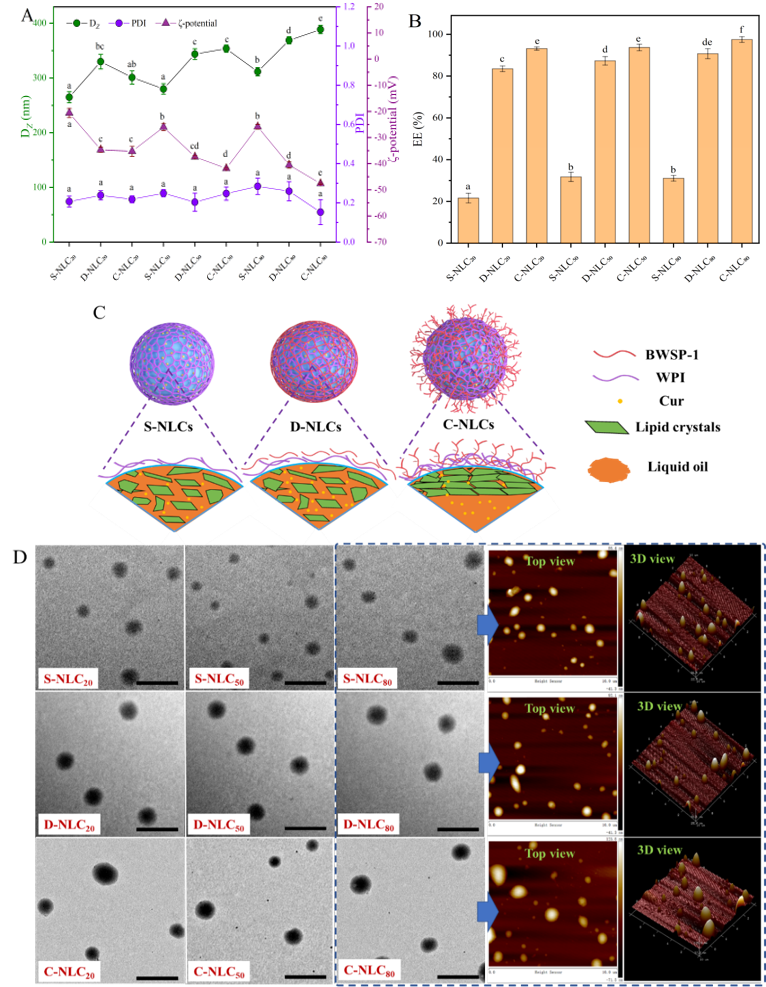
Curcumin (Cur) has been reported to possess many health-benefiting attributes including anti-oxidative, anti-inflammatory, anti-microbial, and anti-carcinogenic effects. Nevertheless, the low solubility, chemical stability, and bioavailability of Cur inhibited their utilization as functional ingredient in the food industry. The development of lipid-based systems for Cur encapsulation has attracted substantial attention in the recent decade, especially those stabilized by food-derived biomacromolecules. Nanostructured lipid carriers (NLCs) can be viewed as a specially type of nanoemulsion, where a considerable proportion of liquid lipid (oil) was replaced by a solid lipid, which endows NLCs with better physical stability, more controlled drug delivery, improved solubility and biocompatibility, and reduced cytotoxicity than the conventional nanoemulsions. In this work, the interfacial structure of NLCs stabilized by whey protein isolate (single layer NLCs, S-NLCs) was modified with polysaccharide through two approaches, and the relationship between the Interface structure, the polymorphic transition and the stability of loaded Cur was discussed. Recently, the research results have been published in “Food Hydrocolloids” and titled “Interfacial engineering strategy to improve the stabilizing effect of curcumin-loaded nanostructured lipid carriers” by JAAS researchers.
Introduction
Herein, NLCs with three kinds of interfacial structure were prepared. At first, the morphology, encapsulation efficiency for Cur, stability against environmental stresses and interfacial viscoelastic properties of S-, D-, and C-NLCs were compared in this work. The polymorphic transition of NLCs were monitored by DSC and XRD techniques, and the relationship between the stability of loaded Cur and the crystal structure was discussed. An in vitro gastrointestinal tract digestion was utilized to investigate the lipolysis kinetics of three types NLCs and the bioavailability of the entrapped Cur. Lastly, the cellular antioxidant activity (CAA) of the nanocarriers was evaluated using a HepG2 cell model.

Conclusions
Two interfacial engineering approaches were utilized herein to enhance the surface structure of NLCs. D- and C-NLCs showed higher DZ values and loading capacity for Cur than S-NLCs. C-NLCs were more resistance against changes in environmental conditions compared with D-NLCs as the biopolymers of the former were more tightly associated with each other. C-NLCs exhibited the highest interfacial compactness, polymorphic stability, and Cur stability, followed by D-NLCs and S-NLCs. The interfacial engineering approaches also inhibited the lipolysis of NLCs during the simulated digestion and improved the transformation, bioaccessibility, and bioavailability of loaded Cur. At last, we revealed that CAA values of Cur-loaded NLC decreased in the following order: C-NLC20 > D-NLC20 > S-NLC20.
Innovativeness
The research provided green and cost-effective ways to enhance the stabilizing effects of NLCs for loaded agents.The Cur-NLCs prepared in this study meet the consumer demand for "clean label" food products and broaden the scope of their application in the food industry.
Read more: https://doi.org/10.1016/j.foodhyd.2022.107552


